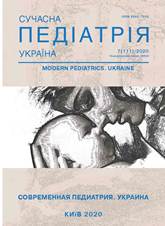Особливості клінічного перебігу алергодерматозів у дітей (огляд літератури)
Keywords:
children, allergy, allergic dermatoses, clinical criteriaAbstract
The prevalence of allergic diseases is constantly growing around the world. According to WHO forecasts, most of the world's population will suffer from various allergies by 2050, at the same time any substance can be an allergen, and the XXI century will be the era of allergies. In the structure of allergic diseases in children the leading place is occupied by allergic skin lesions — allergic dermatoses, which are characterized by pronounced clinical polymorphism, acute or chronic stage with the development of concomitant pathological changes in many systems of the growing child's body. Allergic dermatoses are a large group of skin diseases, including: simple and allergic contact dermatitis, atopic dermatitis, various forms of eczema, acute and chronic allergic urticaria, Quincke's edema, multiforme exudative erythema (Stevens-Johnson syndrome), acute epidermal necrolysis (Lyell's syndrome), toxicodermias, as well as less common dermatoses, in the pathogenesis of which are leading allergic reactions.
Purpose — to describe clinical criteria for the differential diagnosis of allergodermatoses in children in order to increase its effectiveness.
Conclusions. Allergodermatoses in children are characterized by polymorphism of clinical manifestations, which depends on the specific nosology. There is a tendency to increase the frequency of allergic skin diseases in children, especially severe forms with recurrent course, resistant to traditional pharmacotherapy. Comprehensive detailed study of clinical manifestations of allergic dermatoses in children will contribute to the development of differential diagnostic criteria for allergic dermatoses in children, to verify accurate diagnosis and to prescribe the pathogenesis-based treatment for various allergic skin diseases in time.
References
Akan A, Dibek-Misirlroglu E, Civelek E, Vezir E, Kocabas CN. (2020). Diagnosis of atopic dermatitis in children: comparison of the Hanifin-Rajka and the United Kingdom Working Party criteria. Allergologia et Immunopathologia. 48 (2): 175-181. URL: http://www.sciencedirect.com/science/article/pii/S0301054619301156. https://doi.org/10.1016/j.aller.2019.07.008; PMid:31611041
Beltrani VS. (1998). Allergic Dermatoses. Medical Clinics of North America. 82 (5): 1105-1133. URL: http://www.sciencedirect.com/science/article/pii/S0025712505704053. https://doi.org/10.1016/S0025-7125(05)70405-3
Bourrain JL. (2017). Toxicodermias. EMC - Dermatologia. 51 (4): 1-13. URL: http://www.sciencedirect.com/science/article/pii/S1761289617870527. https://doi.org/10.1016/S1761-2896(17)87052-7
Dowling PJ, Kader R, Portnoy JM. (2019). COLA (Conferences On-Line Allergy) at 10 Years - Evolution of an Online Fellowship Curriculum. The Journal of Allergy and Clinical Immunology: In Practice. 7 (8): 2568-2573. URL: http://www.sciencedirect.com/science/article/pii/S2213219819305975. https://doi.org/10.1016/j.jaip.2019.06.025; PMid:31279862
Fawbert K, Leech S. (2020). Recurrent urticaria and angioedema. Paediatrics and Child Health. 30 (7): 243-248. URL: http://www.sciencedirect.com/science/article/pii/S175172222030072X. https://doi.org/10.1016/j.paed.2020.04.001
Hsu DY, Brieva J, Silverberg NB, Paller AS, Silverberg JI. (2017). Pediatric Stevens-Johnson syndrome and toxic epidermal necrolysis in the United States. Journal of the American Academy of Dermatology. 76 (5): 811-817. URL: http://www.sciencedirect.com/science/article/pii/S0190962216312853. https://doi.org/10.1016/j.jaad.2016.12.024; PMid:28285784 PMCid:PMC5502094
Millan GG, Lopez-Bran E. (2018). Toxicodermias. Medicine - Programa de Formacion Medica Continuada Acreditado. 12 (48): 2846-2853. URL: http://www.sciencedirect.com/science/article/pii/S0304541218300076. https://doi.org/10.1016/j.med.2018.01.007
Napolitano M, Fabbrocini G, Patruno C. (2019). Allergic contact dermatitis in patients with atopic dermatitis: A retrospective study. The Journal of Allergy and Clinical Immunology: In Practice. 7 (7): 2459-2461. URL: http://www.sciencedirect.com/science/article/pii/S2213219819303307. https://doi.org/10.1016/j.jaip.2019.03.045; PMid:30954642
Nassau S, Fonacier L. (2020). Allergic Contact Dermatitis. Medical Clinics of North America. 104 (1): 61-76. URL: http://www.sciencedirect.com/science/article/pii/S0025712519300884. https://doi.org/10.1016/j.mcna.2019.08.012; PMid:31757238
Nguyen V, Simon L, Jaqua E. (2016). Allergic Dermatoses. Primary Care: Clinics in Office Practice. 43 (3): 433-449. URL: http://www.sciencedirect.com/science/article/pii/S0095454316300239. https://doi.org/10.1016/j.pop.2016.04.011; PMid:27545733
Noe MH, Micheletti RG. (2020). Diagnosis and management of Stevens-Johnson syndrome/toxic epidermal necrolysis. Clinics in Dermatology. 6: 738-744. URL: http://www.sciencedirect.com/science/article/pii/S0738081X20301498. https://doi.org/10.1016/j.clindermatol.2020.06.016; PMid:33341195
Ozceker D, Haslak F, Dilek F, Sipahi S, Yucel E, Guler N, Tamay Z. (2019). Contact sensitization in children with atopic dermatitis. Allergologia et Immunopathologia. 47 (1): 47-51. URL: http://www.sciencedirect.com/science/article/pii/S0301054618301009. https://doi.org/10.1016/j.aller.2018.06.002; PMid:30193890
Downloads
Published
Issue
Section
License
The policy of the Journal “MODERN PEDIATRICS. UKRAINE” is compatible with the vast majority of funders' of open access and self-archiving policies. The journal provides immediate open access route being convinced that everyone – not only scientists - can benefit from research results, and publishes articles exclusively under open access distribution, with a Creative Commons Attribution-Noncommercial 4.0 international license (СС BY-NC).
Authors transfer the copyright to the Journal “MODERN PEDIATRICS. UKRAINE” when the manuscript is accepted for publication. Authors declare that this manuscript has not been published nor is under simultaneous consideration for publication elsewhere. After publication, the articles become freely available on-line to the public.
Readers have the right to use, distribute, and reproduce articles in any medium, provided the articles and the journal are properly cited.
The use of published materials for commercial purposes is strongly prohibited.

